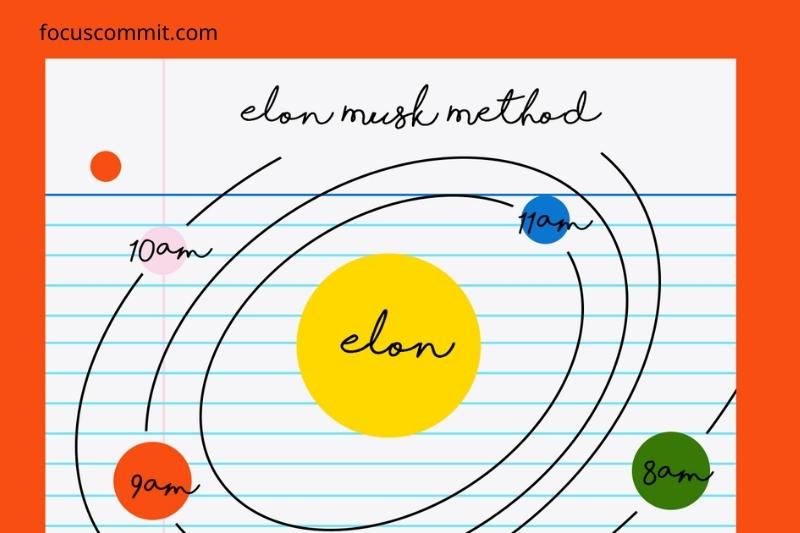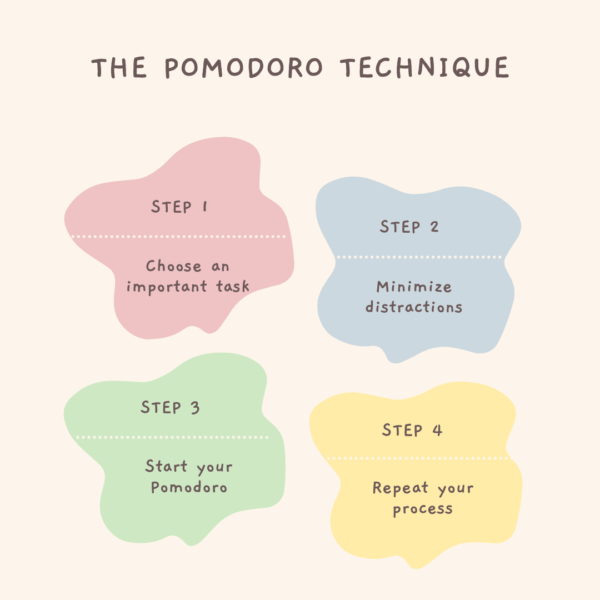orking productively, staying focused, and time management does not an issue for you, especially if you work as a freelancer. Have you ever used the Pomodoro technique at work? What is the real story behind this technique?
What exactly is the Pomodoro technique?
Francesco Cirillo, a software developer and entrepreneur, invented the Pomodoro Technique in the 1990s. When Cirillo was a university student, he used a tomato-shaped kitchen timer to divide his total study time into 25-minute intervals called Pomodoros (from the Italian word for tomato) to complete his tasks.
In a nutshell, Pomodoro ensures that you get stuck and only focus on one task for 25 minutes before taking a 5-minute break. This tool assists you in managing your framework, improving your focusing, and studying productively.
But have you ever heard of Elon Musk‘s (EM) Time Blocking? Is there a distinction between Elon Musk’s Time Blocking method and the Pomodoro Technique? To begin, EM divides his time into many five-minute increments or time blocks rather than a Pomodoro of Cirillo’s 25 minutes.
Second, time-blocking forces you to fill free time with pre-commitments and an action plan. By doing so, you avoid wasting valuable time on a task that could be completed more quickly, whereas Pomodoro takes 25 minutes to complete a task and work tends to expand to fill the time allotted for it. Both time-blocking and the Pomodoro Technique are time management method on such a hectic schedule.
How does the Pomodoro Technique work?
Now that you know what Pomodoro is, how do you apply it? There are four steps to completing a Pomodoro Technique.
- Choose an important task that needs to be completed and write it down. When you begin doing something, you must respond to the question, “what do you do?” It means to select tasks by considering what you want to do and making a list of what we want to accomplish. It is critical to identify which goals you want to achieve and the steps you need to take to get there.
- Minimize distractions that prevent you from concentration. One of the keys that Pomodoro teaches you is to manage distractions rather than time with your task. Close all tabs, emails, social media, turn your phone to do not disturb, and even close the door to maximize focus. Then, for your task, set a Pomodoro timer
for 25 minutes, followed by a 5-minute break. - Start working your Pomodoro: work on that one thing for 25 minutes without stopping, and then take a short break when the bell rings. Doing the task without pausing, staying focused on your work for the duration of the session, and ignoring all distractions around you. If you still have time, double-check your work to ensure it is error-free. Take note that during your short break, you should take a step away from your task, clear your mind, and grab a refreshment. It allows you to de-stress before beginning another session.
- Repeat your process: After a short break, what you have to do in the fourth step is to repeat your process from step 1 to step 3 fourth times. Take a 20-minute or a 30-minute longer break after completing your fourth session and come back refreshed. This is how the Pomodoro system works.

How effective is the Pomodoro Technique?
You can use this technique to overcome procrastination, improve your focusing, and work more productively.
Pomodoro beats procrastination by requiring you to log out of social media, close tabs, or even leave your social environment.
Procrastination, as you know, is the thief of time, and you will learn to avoid it by ignoring all distractions and sorting all tasks according to priority and putting them in a to-do list. With a time limit, you’ll work for the next 25 minutes, focusing solely on your chosen task and doing your best to complete it before taking a break. All you have to do is finish your tasks and enjoy your break—no checking email, responding to messages, or even talking to friends.
The Pomodoro technique puts you in a race against the clock to improve your concentration. When we are really focused and in the flow, we are all capable of concentration. Perhaps it relieves the stress of a deadline, working late at night, or wearing headphones.
You put an end to procrastination and multitasking and get to work.
With a to-do list, you’ll develop the habit of “doing everything today,” and you intend to complete this list. So the rest is to divide what you need to do into tasks, and each task is proportional to a Pomodoro. When doing a true Pomodoro, you will learn to tame your wandering mind and achieve better focus.
As a result, when you fight procrastination, focus completely on your task, and combine work with a break, your productivity will undoubtedly increase. Every task serves as the focal point for your goal, and the Pomodoro Technique will show you how to effectively detach from the impact on continuity.
In other words, monotasking outperforms multitasking.
Our brain is not designed to work on multiple projects at the same time. A Stanford University study, for example, found that people who multitask are more easily distracted, less productive, make more mistakes, and perform worse on memory tests. So, instead of multitasking, focus on monotasking to maximize your productivity.
Is Pomodoro fixed for 25 minutes?
People are probably wondering why Cirillo chose a 25-minute interval. Is it too long or too short for the task at hand? A Pomodoro lasts 25 minutes, according to Cirillo, and it’s written in stone. However, if you are using this technique for yourself, you can adjust the time to suit your needs. Many tasks, as you know, take a long time to complete, and 25 minutes is just a kind of compromise on the edge of comfort. You should divide a large piece of work into smaller, similar-sized pieces and complete it in stages.
If you’re unsure how to fit your task into a Pomodoro session or vice versa, Parkinson’s Law may be able to help. “Work expands to fill the time available for completion,” it said. In layman’s terms, your plan is based on how much time you have, and as the deadline approaches, you begin to make choices and tradeoffs to complete the task by the deadline. For instance, suppose you have two weeks to plan a birthday party for your best friend. It’s more than enough time to book a conference room, bake a birthday cake, and make some thoughtful gifts.
You realize you have more time on your hands, so you make an embarrassing slideshow, decorate the room with many balloons, make some handmade cards, and so on, which causes the party to grow and become more and more complex.
As a result, you can tailor your Pomodoro to your specific needs and tasks. Furthermore, you should find a “partner,” which is actually a support tool, such as a Focus Commit that shows the process of your Pomodoro and rings between sessions.

Who the Pomodoro Technique works best for?
The Pomodoro Technique is beneficial to everyone, but it is especially beneficial to developers, designers, and other people who must produce regular packages of creative work. Many people nowadays work as freelancers, offering services or working on multiple jobs for multiple clients.
You should be able to set your own schedules, run your own business, and live a flexible lifestyle. But that means you’re the only one who gets to decide what, how, and when to play the tune. You waste time, muck up your work, and may even miss out on some tasks if you aren’t tough on yourself.
The Pomodoro Technique teaches you to focus on as much as possible while increasing productivity by completing tasks one at a time.
Pros and Cons of the Pomodoro Technique?
The fact that no technique is flawless, and the Pomodoro is no exception. There are some advantages and disadvantages that you should be aware of.
To the Pomodoro’s advantages:
- Better your time management skill: It helps you list what you have to do, estimate how much time you spent on, keep track of your progress, and take an overview of your business. And so, you can avoid time-consuming or missing out any tasks, keep your workflow, and control all your business better. Furthermore, focus and flow have tremendous power, and the Pomodoro Technique focuses on that sort of intense concentration. While many people swear by multitasking, you are fully in the “one thing at a time” camp.
- Improve productivity: When people split their work into many tasks and perform them with maximum attention and care, the intended result is achieved. Tension is reduced by dividing projects down into a certain number of Pomodoros, which allows us to identify and assess our efficacy and productivity.
On the other hand, the Pomodoro can occasionally cause problems for the user.
- Lost your workflow: Sometimes, a great idea on a whim, so you rush to keep up with your thoughts as you write. This can create an increasingly rare hyper flow that turns you into a content-producing machine. When a buzzer goes off after twenty-five minutes of focus, you risk disturbing the welcoming flow of concentration. It can be an unexpected interruption that makes you lose your workflow.
- It’s too difficult to follow the Pomodoro Technique’s rule: if you work in an office with other people, it’s too difficult to avoid distractions at work. They will either ask you a question or simply talk to each other, which will be a distraction. The Pomodoro requires some special environmental conditions to function properly, so not every location is suitable.
- Some tasks are not big enough for a Pomodoro: as you know, some tasks are too short of completing in 25 minutes. In this case, you have to group these small tasks into one Pomodoro, and it seems like you’re multitasking.
Conclusion
Despite its pros and cons, the Pomodoro technique wouldn’t have become so popular if it wasn’t a productivity hack for many people. Remember that the goal of Pomodoro is progress, not perfection. Have fun with it!
Photo by Alex Ghizila on Unsplash

